This article details the subsidy possibilities offered by Hydro-Québec’s Efficient Solutions program for the various ways of recovering heat in commercial, industrial, institutional and agricultural buildings. This includes multi-unit dwellings of 20 units or more, which are also eligible under this program.
Why heat recovery?
Most buildings need to exchange indoor air with outdoor air to ensure air quality, maintain humidity levels and remove pollutants. In Quebec, since outdoor air is colder than indoor air most of the time, a great deal of energy must be used to heat outdoor air when it enters the building. It therefore makes sense to provide some form of heat recovery to improve the building’s energy efficiency.
Heat recovery can be achieved in a number of ways. The most common is that mentioned above, in relation to the ventilation system. However, there are many other possibilities, such as recovering heat from grey water, refrigeration systems, industrial processes and computer systems. In all these cases, the heat is simply rejected in whole or in part, when it could be re-used to heat the building’s air or water. Heat recovery is particularly important in cold climates and, as well as being environmentally friendly and economical, it also enhances comfort.
How to recover heat?
Heat recovery in ventilation systems
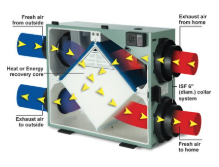
This involves installing an air exchanger with an integrated heat recovery unit to transfer heat from the outgoing indoor air to the incoming outdoor air.
The heat exchanger can be a plate heat exchanger (enthalpy cube), as found in most residential or light commercial exchangers. A plate heat exchanger transfers heat between extracted (hot) and fresh (cold) air via metal or plastic plates, without mixing the air streams. This technology is around 65% efficient. Potential subsidies are about $167 per 100 CFM of recovery:
120 CFM plate recuperator: $200
1,000 CFM plate recuperator: $1,670
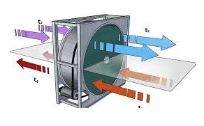 More efficient technologies include thermal wheel heat exchangers. A rotating wheel made of highly thermally conductive material rotates between extracted and fresh air. The wheel absorbs heat (and sometimes humidity) from one flow and releases it to the other. This technology is around 75-85% efficient. Potential subsidies are around $250 per 100 CFM of recovery:
More efficient technologies include thermal wheel heat exchangers. A rotating wheel made of highly thermally conductive material rotates between extracted and fresh air. The wheel absorbs heat (and sometimes humidity) from one flow and releases it to the other. This technology is around 75-85% efficient. Potential subsidies are around $250 per 100 CFM of recovery:
1,000 CFM heat wheel recuperator: $2,500
Recuperator per 5,000 CFM heat wheel: $12,500
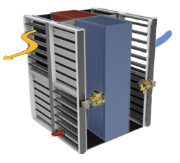 The most efficient technology is a cassette regenerative recuperator. This system uses a refractory or ceramic material to accumulate heat from the extracted air before transferring it to the fresh air. Air flows alternate via valves (regenerative system). This technology is up to 95% efficient. Potential subsidies are approximately $620 per 100 CFM of recovery:
The most efficient technology is a cassette regenerative recuperator. This system uses a refractory or ceramic material to accumulate heat from the extracted air before transferring it to the fresh air. Air flows alternate via valves (regenerative system). This technology is up to 95% efficient. Potential subsidies are approximately $620 per 100 CFM of recovery:
Recuperator per 5,000 CFM cassette: $31,000
Recuperator per 10,000 CFM cassette: $62,000
Grey water heat recovery
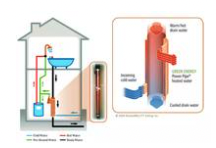 A measure that involves installing a heat recovery unit around wastewater plumbing pipes to transfer the heat to the clean water entering the building. The aim is to preheat the clean water used in the building before it goes to the water heater, thereby reducing the amount of energy needed to heat the water. The program offers a subsidy for each heat recovery unit installed in a building.
A measure that involves installing a heat recovery unit around wastewater plumbing pipes to transfer the heat to the clean water entering the building. The aim is to preheat the clean water used in the building before it goes to the water heater, thereby reducing the amount of energy needed to heat the water. The program offers a subsidy for each heat recovery unit installed in a building.
Potential subsidy: $250 per recovery unit
Heat recovery from computer systems
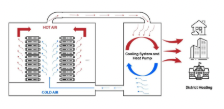
Computers produce a great deal of heat to operate. Rooms containing a large number of computing devices, such as servers or data centers, will generally have excessive heat that needs to be dissipated. Rather than being vented directly to the outside, this heat can be recovered in a number of ways. One way is to install a heat pump condenser, which draws heat from the computer room and transfers it to other rooms in the building that need to be heated. At the same time, the condenser rejects the cold, thus cooling the room.
24,000 BTU heat pump: $2,500
In conclusion, the best way to recover heat depends on the type of building, the equipment in place, the uses and the budgets available. Grants from the Efficient Solutions program are very generous for these measures, and can make your project much more cost-effective, in addition to improving the building’s energy efficiency, your ecological footprint, your savings and user comfort.
There are countless heat recovery methods that are not included in the “Simplified Offer” of the Efficient Solutions program. However, this same program includes a “Customized Offer” that allows you to subsidize your unique project based on the kW/h savings achieved.
We hope you find this information useful in helping your customers make the most of the subsidies available to them. We remain available at all times to assist you with your projects, calculate potential subsidy amounts for your proposals and apply for subsidies for your projects.
